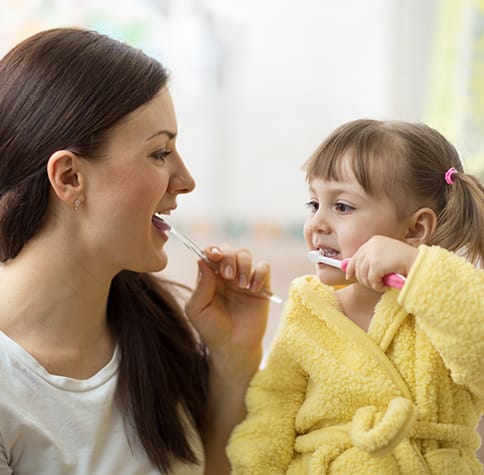How to Take Care of Your Child's Teeth at Home
The most important things you can do for your children’s oral and dental well-being is to get them brushing (and flossing) as early as possible.
There are 3 primary things to consider when helping children develop good brushing habits: when to begin, how to do it and how often.
Parents and caregivers should begin brushing their infants’ teeth when their first tooth erupts! Use only water or a tiny amount of non-fluoridated toothpaste and a very soft toothbrush.
Even before eruption, the mouth can be cleaned with a soft wash cloth.
After the age of 2, a grain of rice sized amount of fluoride toothpaste can be introduced for night-time brushing. Parent-aided brushing should continue until the age of 8-9, or until your child has developed the manual dexterity to wash your crystal glasses!
Teaching kids great brushing technique is as important as getting them used to brushing:
Aim to have your kids brush 2-3 times a day, every day. It is ideal to disrupt cavity-causing plaque at least every 12 hours!
Help get them into the habit of doing so at regular times, such as:
And remember: as soon as their toothbrush starts to look worn or frayed, it’s time for a new one!


Flossing should become part of your children’s daily dental routine as soon as possible. Your little one’s gums may bleed a little as they begin flossing and their gums adjust to this new experience; this is normal. But if it continues after you or they have gently flossed their teeth several times, consult your pediatric dentist.
You can start with floss sticks for toddlers, but multiple floss sticks have to be used for an entire mouth in order to prevent cross contamination! It is ideal to progress to string once children are 3 years of age.
Help your kids get used to flossing every day once they have 2 or more teeth touching each other.
At least once a day, especially after eating foods that tend to get trapped in teeth or are sugary.
The American Academy of Pediatric Dentistry (AAPD) recognizes the benefits of xylitol on the oral health of infants, children, adolescents, and persons with special health care needs.
The use of Xylitol gum by mothers (2-3 times per day) starting 3 months after delivery and until the child was 2 years old, has proven to reduce cavities up to 70% by the time the child was 5 years old.
Studies using xylitol as either a sugar substitute or a small dietary addition have demonstrated a dramatic reduction in new tooth decay, along with some reversal of existing dental caries. Xylitol effects are long-lasting and possibly permanent. Low decay rates persist even years after the trials have been completed.
Xylitol is widely distributed throughout nature in small amounts. Some of the best sources are fruits, berries, mushrooms, lettuce, hardwoods, and corn cobs. One cup of raspberries contains less than one gram of xylitol.
To find gum or other products containing xylitol, try visiting your local health food store for products containing 100% xylitol.
We are your children's pediatric dental specialists in Southwest Calgary.